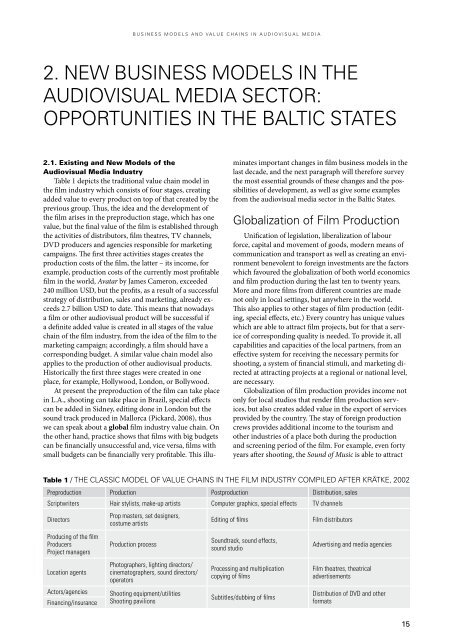Business Models and Value Chains in Audiovisual ... - First Motion
Business Models and Value Chains in Audiovisual ... - First Motion
Business Models and Value Chains in Audiovisual ... - First Motion
Create successful ePaper yourself
Turn your PDF publications into a flip-book with our unique Google optimized e-Paper software.
<strong>Bus<strong>in</strong>ess</strong> <strong>Models</strong> <strong>and</strong> <strong>Value</strong> <strong>Cha<strong>in</strong>s</strong> <strong>in</strong> <strong>Audiovisual</strong> Media<br />
2. New <strong>Bus<strong>in</strong>ess</strong> <strong>Models</strong> <strong>in</strong> the<br />
<strong>Audiovisual</strong> Media Sector:<br />
Opportunities <strong>in</strong> the Baltic States<br />
2.1. Exist<strong>in</strong>g <strong>and</strong> New <strong>Models</strong> of the<br />
<strong>Audiovisual</strong> Media Industry<br />
Table 1 depicts the traditional value cha<strong>in</strong> model <strong>in</strong><br />
the film <strong>in</strong>dustry which consists of four stages, creat<strong>in</strong>g<br />
added value to every product on top of that created by the<br />
previous group. Thus, the idea <strong>and</strong> the development of<br />
the film arises <strong>in</strong> the preproduction stage, which has one<br />
value, but the f<strong>in</strong>al value of the film is established through<br />
the activities of distributors, film theatres, TV channels,<br />
DVD producers <strong>and</strong> agencies responsible for market<strong>in</strong>g<br />
campaigns. The first three activities stages creates the<br />
production costs of the film, the latter – its <strong>in</strong>come, for<br />
example, production costs of the currently most profitable<br />
film <strong>in</strong> the world, Avatar by James Cameron, exceeded<br />
240 million USD, but the profits, as a result of a successful<br />
strategy of distribution, sales <strong>and</strong> market<strong>in</strong>g, already exceeds<br />
2.7 billion USD to date. This means that nowadays<br />
a film or other audiovisual product will be successful if<br />
a def<strong>in</strong>ite added value is created <strong>in</strong> all stages of the value<br />
cha<strong>in</strong> of the film <strong>in</strong>dustry, from the idea of the film to the<br />
market<strong>in</strong>g campaign; accord<strong>in</strong>gly, a film should have a<br />
correspond<strong>in</strong>g budget. A similar value cha<strong>in</strong> model also<br />
applies to the production of other audiovisual products.<br />
Historically the first three stages were created <strong>in</strong> one<br />
place, for example, Hollywood, London, or Bollywood.<br />
At present the preproduction of the film can take place<br />
<strong>in</strong> L.A., shoot<strong>in</strong>g can take place <strong>in</strong> Brazil, special effects<br />
can be added <strong>in</strong> Sidney, edit<strong>in</strong>g done <strong>in</strong> London but the<br />
sound track produced <strong>in</strong> Mallorca (Pickard, 2008), thus<br />
we can speak about a global film <strong>in</strong>dustry value cha<strong>in</strong>. On<br />
the other h<strong>and</strong>, practice shows that films with big budgets<br />
can be f<strong>in</strong>ancially unsuccessful <strong>and</strong>, vice versa, films with<br />
small budgets can be f<strong>in</strong>ancially very profitable. This illum<strong>in</strong>ates<br />
important changes <strong>in</strong> film bus<strong>in</strong>ess models <strong>in</strong> the<br />
last decade, <strong>and</strong> the next paragraph will therefore survey<br />
the most essential grounds of these changes <strong>and</strong> the possibilities<br />
of development, as well as give some examples<br />
from the audiovisual media sector <strong>in</strong> the Baltic States.<br />
Globalization of Film Production<br />
Unification of legislation, liberalization of labour<br />
force, capital <strong>and</strong> movement of goods, modern means of<br />
communication <strong>and</strong> transport as well as creat<strong>in</strong>g an environment<br />
benevolent to foreign <strong>in</strong>vestments are the factors<br />
which favoured the globalization of both world economics<br />
<strong>and</strong> film production dur<strong>in</strong>g the last ten to twenty years.<br />
More <strong>and</strong> more films from different countries are made<br />
not only <strong>in</strong> local sett<strong>in</strong>gs, but anywhere <strong>in</strong> the world.<br />
This also applies to other stages of film production (edit<strong>in</strong>g,<br />
special effects, etc.) Every country has unique values<br />
which are able to attract film projects, but for that a service<br />
of correspond<strong>in</strong>g quality is needed. To provide it, all<br />
capabilities <strong>and</strong> capacities of the local partners, from an<br />
effective system for receiv<strong>in</strong>g the necessary permits for<br />
shoot<strong>in</strong>g, a system of f<strong>in</strong>ancial stimuli, <strong>and</strong> market<strong>in</strong>g directed<br />
at attract<strong>in</strong>g projects at a regional or national level,<br />
are necessary.<br />
Globalization of film production provides <strong>in</strong>come not<br />
only for local studios that render film production services,<br />
but also creates added value <strong>in</strong> the export of services<br />
provided by the country. The stay of foreign production<br />
crews provides additional <strong>in</strong>come to the tourism <strong>and</strong><br />
other <strong>in</strong>dustries of a place both dur<strong>in</strong>g the production<br />
<strong>and</strong> screen<strong>in</strong>g period of the film. For example, even forty<br />
years after shoot<strong>in</strong>g, the Sound of Music is able to attract<br />
Table 1 / The Classic Model of <strong>Value</strong> <strong>Cha<strong>in</strong>s</strong> <strong>in</strong> the Film Industry Compiled after Krätke, 2002<br />
Preproduction Production Postproduction Distribution, sales<br />
Scriptwriters Hair stylists, make-up artists Computer graphics, special effects TV channels<br />
Directors<br />
Produc<strong>in</strong>g of the film<br />
Producers<br />
Project managers<br />
Location agents<br />
Actors/agencies<br />
F<strong>in</strong>anc<strong>in</strong>g/<strong>in</strong>surance<br />
Prop masters, set designers,<br />
costume artists<br />
Production process<br />
Photographers, light<strong>in</strong>g directors/<br />
c<strong>in</strong>ematographers, sound directors/<br />
operators<br />
Shoot<strong>in</strong>g equipment/utilities<br />
Shoot<strong>in</strong>g pavilions<br />
Edit<strong>in</strong>g of films<br />
Soundtrack, sound effects,<br />
sound studio<br />
Process<strong>in</strong>g <strong>and</strong> multiplication<br />
copy<strong>in</strong>g of films<br />
Subtitles/dubb<strong>in</strong>g of films<br />
Film distributors<br />
Advertis<strong>in</strong>g <strong>and</strong> media agencies<br />
Film theatres, theatrical<br />
advertisements<br />
Distribution of DVD <strong>and</strong> other<br />
formats<br />
15
















